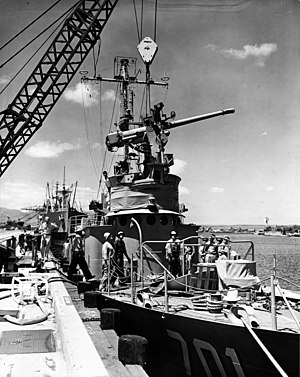Battle of Korea Strait
| Battle of Korea Strait | |||||||
|---|---|---|---|---|---|---|---|
| Part of the Korean War | |||||||
 ROKS Bak Du San being rearmed in Hawaii, March 1950 | |||||||
| |||||||
| Belligerents | |||||||
|
|
| ||||||
| Units involved | |||||||
| Korean People's Navy | Republic of Korea Navy | ||||||
| Strength | |||||||
| 1 steamer[1] |
1 submarine chaser : | ||||||
| Casualties and losses | |||||||
|
600 killed or wounded 1 steamer sunk [1] |
2 killed 2 wounded 1 submarine chaser damaged [1] | ||||||
The Battle of Korea Strait was a single ship action fought on the first day of the Korean War, 25–26 June 1950, between the navies of South Korea and North Korea. A North Korean troop transport carrying hundreds of soldiers attempted to land its invasion force near Busan but was encountered by a South Korean patrol ship and sunk. It was one of the first surface actions of the war and resulted in an important South Korean victory.[2][3]
Battle
[edit]
The Korean War began on 25 June 1950 with a massive North Korean invasion of South Korea which nearly overran the country. During the invasion, a North Korean steamer was assigned to insert troops along the peninsula's southeastern coast.[3] The merchant ship of 1,000 tons was armed with machine guns and loaded with 600 soldiers of the 766th Independent Infantry Regiment.[4]
It was early morning when the Republic of Korea Navy submarine chaser ROKS Pak Tu San spotted the lone enemy steamer eighteen miles from Busan.[4] The chaser, also formerly American, was the lead vessel of the South Korean Navy.[5]
Bak Du San first challenged the steamer with signal lights and received no response. But when the South Koreans turned on their searchlights, the North Koreans opened fire, hitting the Bak Du San's bridge. The helmsman was killed and the officer of the deck seriously wounded. Bak Du San returned fire with her main 3-inch anti-aircraft gun and six .50-caliber machine guns.[5] After the North Koreans began taking hits, they attempted to flee the engagement, but were chased by the Bak Du San in a running battle that ended with the steamer being sunk near Tsushima Island, with heavy loss of life.
The victory was a major strategic gain. Busan was vital but only lightly defended, and if it had fallen the North Koreans would have been one step closer to completely overrunning the country. [1]
See also
[edit]Notes
[edit]- ^ a b c d e "How a Lone $60,000 Patrol Boat and Its Single Deck Gun Changed the Course of the Korean War". The National Interest. 7 September 2019. Retrieved 19 October 2020.
- ^ J. Marolda, Edward (26 August 2003). "Naval Battles". Naval History & Heritage Command. Retrieved 20 November 2010.
- ^ a b Rottman 2001, p. 171
- ^ a b "ROK Navy Ships: Pak Tu San (PC-701, 1950–60)". Naval History & Heritage Command. 17 October 1999. Archived from the original on 5 December 2010. Retrieved 20 November 2010.
References
[edit]- Rottman, Gordon (2001), Korean War Order of Battle: United States, United Nations, and Communist Ground, Naval, and Air Forces, 1950–1953, Westport, Connecticut: Praeger Publishers, ISBN 978-0-275-97835-8
